Page 269 of 395
Downloaded from www.Manualslib.com manuals search engine ENGINE OIL
A CHECK OIL LEVEL message will appear whcn the engine oil is
approximately a quart low. If the message is displayed, check the dipstick
level
and add oil as needed.
It's
a good idea to check your engine oil every time you get fuel. In order
to get
an accurate reading, the oil must be warm and the vehicle must be
on level ground.
Turn off the engine and
give the oil a few
minutes to drain back
into the
oil pan. If you
don't, the oil dipstick
might not
show the
actual level.
6- 10
Page 273 of 395
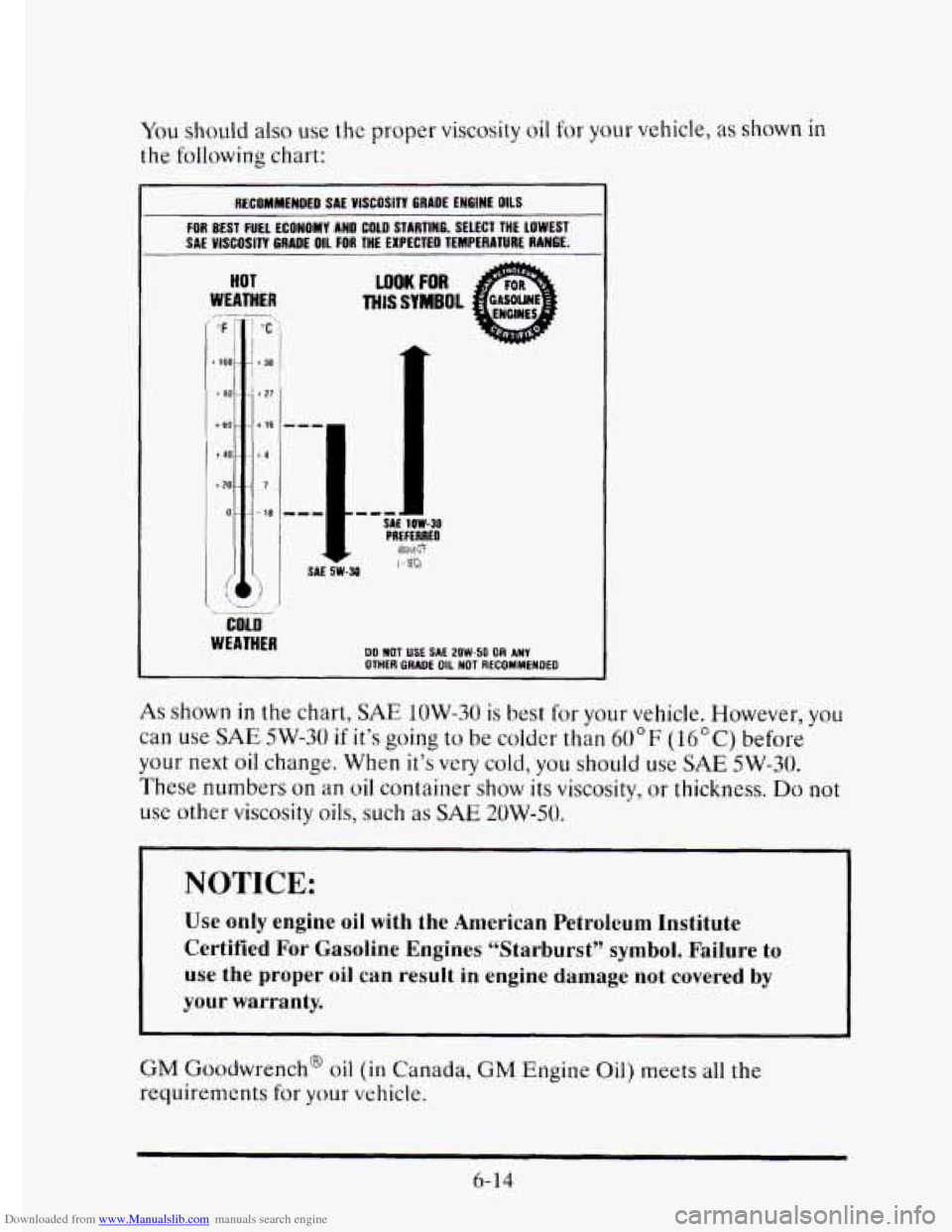
Downloaded from www.Manualslib.com manuals search engine You should also use the proper viscosity oil for your vehicle, as shown in
the following chart:
I RECOMMENDED SAE YISCOSITY GRADE ENGINE OILS I
SAE VISCOSITV GRADE OIL FOR IHE EXPECTED TEMPERAlURE
RANGE. 1
FOR BEST FUEL ECONOMY AND COLD STARTING. SELECT THE LOWEST
DO NOT USE SAE 2OW-50 OR ANY OTHER GRADE OIL NOT RECOMMENDEO
As shown in the chart, SAE 1OW-30 is best
for your vehicle. However, you
can use
SAE SW-30 if it's going to be colder than 60°F (16OC) before
your next
oil change. When it's very cold, you should use SAE SW-30.
These numbers on an oil container show its viscosity, or thickness. Do not
use other viscosity oils, such as SM 20W-SO.
~~~~~~ ~ ~~~~ ~~ ~ ~ ~~~
~
NOTICE:
Use only engine oil with the American Petroleum Institute
Certified For Gasoline Engines "Starburst"
symbol. Failure to
use the proper oil can result in engine damage not covered by
your warranty.
6-14
GM Goodwrench@ oil (in Canada, GM Engine Oil) meets all the
requirements
for your vehicle.
Page 302 of 395
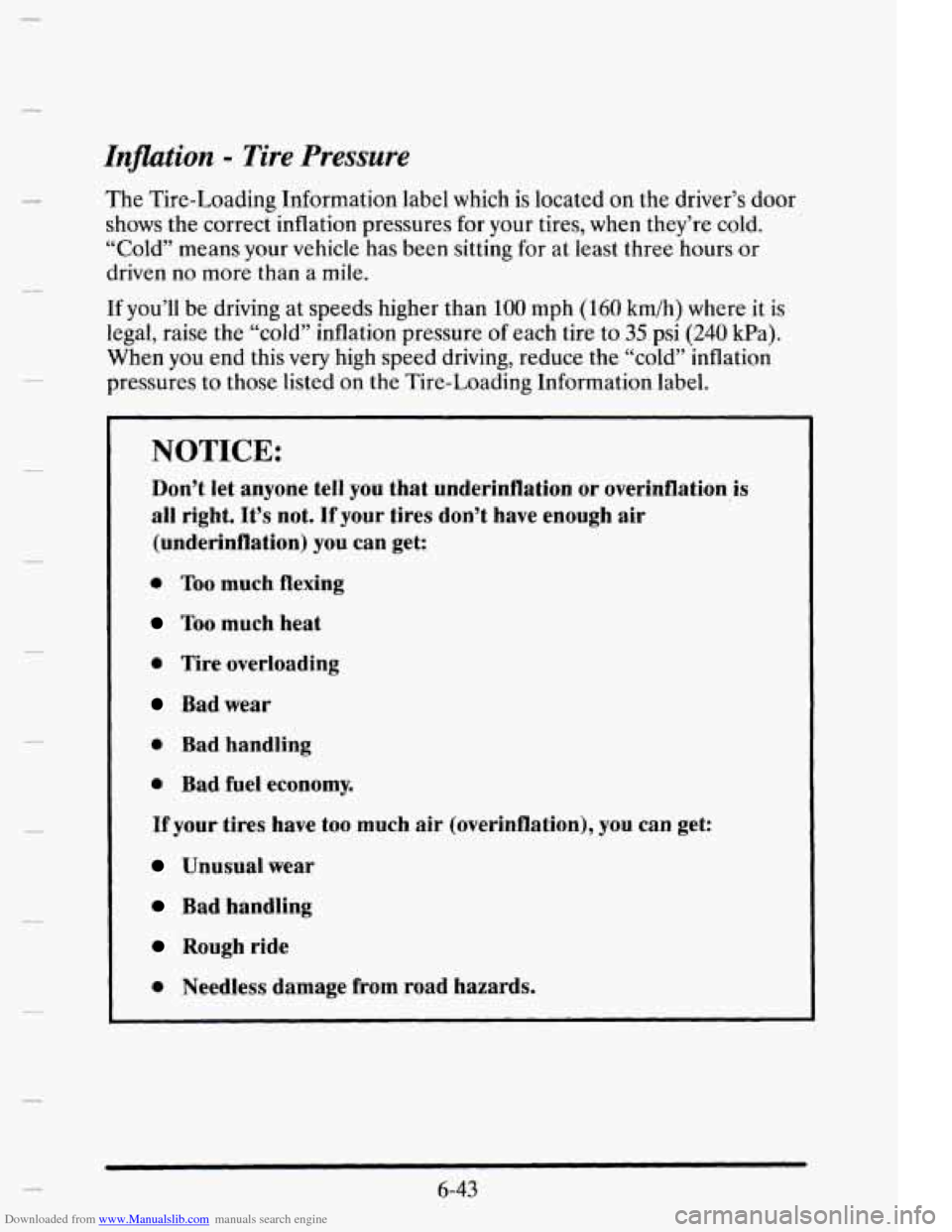
Downloaded from www.Manualslib.com manuals search engine Inflation - Tire Pressure
The Tire-Loading Information label which is located on the driver’s door
shows the correct inflation pressures for
your tires, when they’re cold.
“Cold” means your vehicle has been sitting for at least three hours or
driven
no more than a mile.
If you’ll be driving at speeds higher than 100 mph (160 km/h) where it is
legal, raise the “cold” inflation pressure
of each tire to 35 psi (240 kPa).
When you end this very high speed driving, reduce the “cold” inflation
pressures to those listed
on the Tire-Loading Information label.
NOTICE:
Don’t let anyone tell you that underinflation or overinflation,is
all right. It’s not.
If your tires don’t have enough air
(underinflation) you can get:
0 Too much flexing
Too much heat
0 Tire overloading
Bad wear
0 Bad handling
0 Bad fuel economy.
If your tires have too much air (overinflation), you can get:
Unusual wear
Bad handling
Rough ride
0 Needless damage from road hazards.
6-43
Page 318 of 395
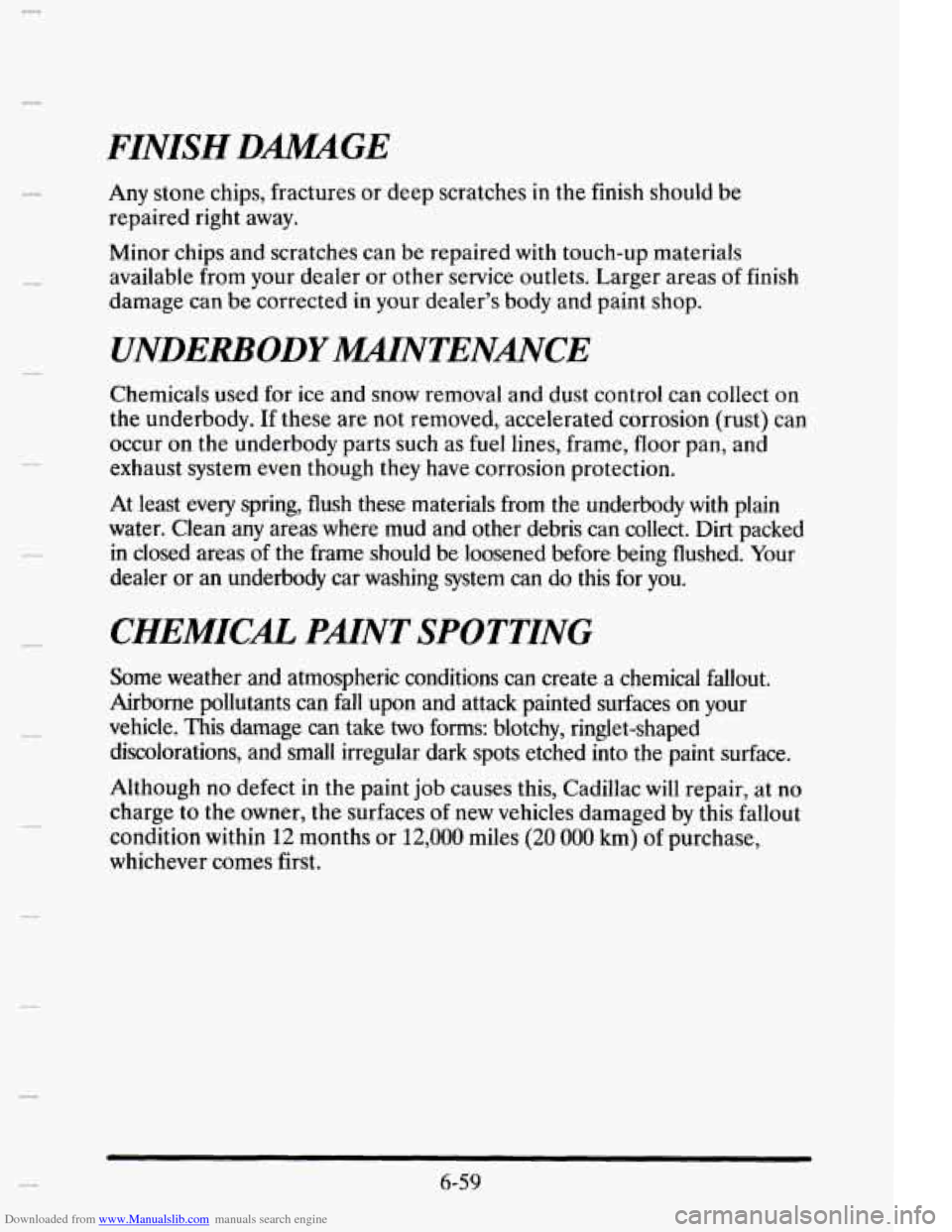
Downloaded from www.Manualslib.com manuals search engine FINISH DMGE
Any stone chips, fractures or deep scratches in the finish should be
repaired right away.
Minor chips and scratches can be repaired
with touch-up materials
available from your dealer or other service outlets. Larger areas
of finish
damage can be corrected
in your dealer’s body and paint shop.
UNDERBODYMNTENANCE
Chemicals used for ice and snow removal and dust control can collect on
the underbody. If these are not removed, accelerated corrosion (rust) can
occur on the underbody parts such
as fuel lines, frame, floor pan, and
exhaust system
even though they have corrosion protection.
At least
every spring, flush these materials from the underbody with plain
water. Clean any areas where mud and other debris can collect.
Dirt packed
in closed areas of the frame should be loosened before being flushed. Your
dealer or an underbody car washing system can do this for
you.
CHEMICAL PMNT SPOTTING
Some weather and atmospheric conditions can create a chemical fallout.
Airborne pollutants can fall upon and attack painted surfaces on your
vehicle. This damage can take
two forms: blotchy, ringlet-shaped
discolorations, and small irregular dark spots etched into the paint surface.
Although
no defect in the paint job causes this, Cadillac will repair, at no
charge to the owner, the surfaces of new vehicles damaged by this fallout
condition within
12 months or 12,000 miles (20 000 km) of purchase,
whichever
comes first.
6-59
Page 321 of 395
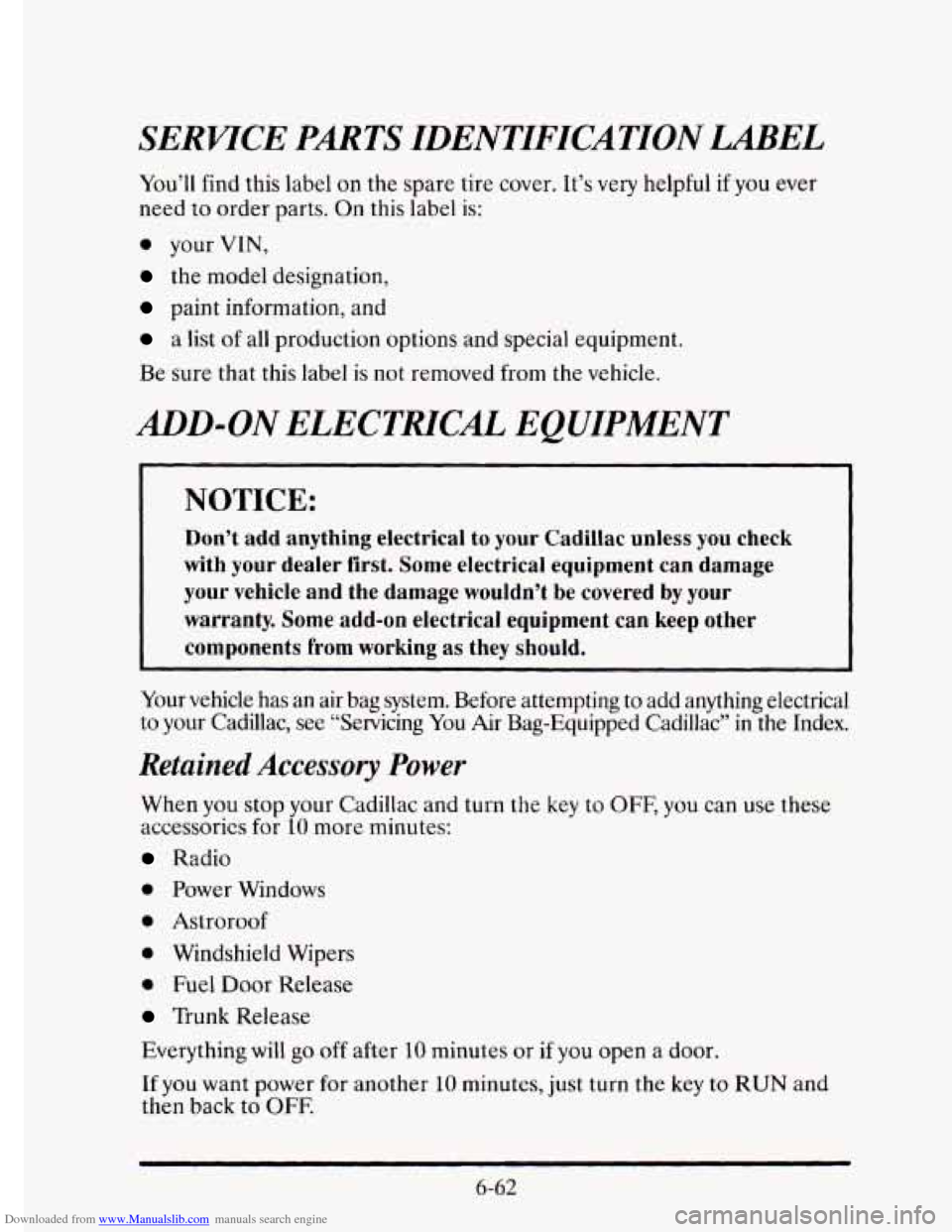
Downloaded from www.Manualslib.com manuals search engine SERWCE PARTS IDENTIFICATION LABEL
You’ll find this label on the spare tire cover. It’s very helpful if you ever
need
to order parts. On this label is:
0 your VTN,
the model designation,
paint information, and
a list of all production options and special equipment.
Be sure that this label
is not removed from the vehicle.
ADD=ON ELECTMCL EQUIPMENT
NOTICE:
Don’t add anything electrical to your Cadillac unless you check
with your dealer first. Some electrical equipment can damage
your vehicle and the damage wouldn’t be covered by your
warranty. Some add-on electrical equipment can keep other
components
from working as they should.
Your vehicle has an air bag system. Before attempting to add anything electrical
to your Cadillac, see “Servicing You Air Bag-Equipped Cadillac” in the Index.
Retained Accessory Power
When you stop your Cadillac and turn the key to OFF, you can use these
accessorics
for 10 more minutes:
Radio
0 Power Windows
0 Astroroof
0 Windshield Wipers
0 Fuel Door Release
Trunk Release
Everything will
go off after 10 minutes or if you open a door.
6-62
If you want power for another 10 minutes, just turn the key to RUN and
then back to OW.
Page 324 of 395
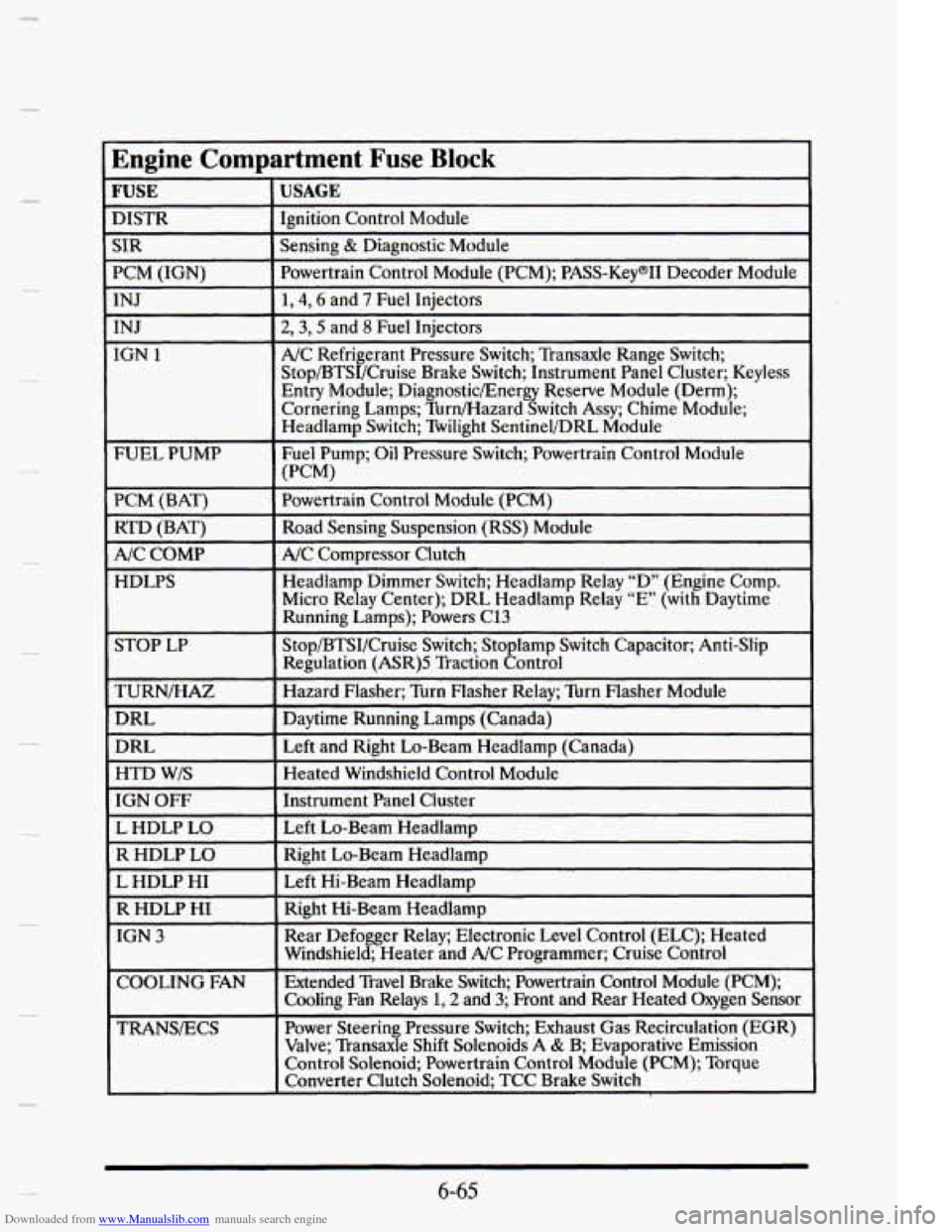
Downloaded from www.Manualslib.com manuals search engine [Engine Compartment Fuse Block
~~~
E DISTR
USAGE I
INJ
IGN 1
FUEL PUMP
PCM (BAT) RTD (BAT)
F
A/C COMP
HDLPS
TURN/HAZ
DRL
DRL
HTD W/S
IGN OFF
L HDLP
LO
I R HDLP LO Ignition
Control Module
I
L HDLP HI
R HDLP HI
I
I
TRANSECS Sensing
& Diagnostic Module
Powertrain Control Module (PCM); PASS-KeymII Decode llodule
1,4,6 and 7 Fuel Injectors
2,3,5 and 8 Fuel Injectors
A/C Refrigerant Pressure Switch; Transaxle Range Switch;
Stop/BTSI/Cruise Brake Switch; Instrument Panel Cluster; Keyless
Entry Module; DiagnosticEnergy Reserve Module (Derm);
Cornering Lamps; Tbrn/Hazard Switch Assy; Chime Module;
Headlamp Switch; Twilight Sentinel/DRL Module
Fuel Pump; Oil Pressure Switch; Powertrain Control Module
Powertrain Control Module (PCM)
Road Sensing Suspension (RSS) Module
NC Compressor Clutch
Headlamp Dimmer Switch; Headlamp Relay “D” (Engine Comp.
Micro Relay Center); DRL Headlamp Relay
“E’ (with Daytime
Running Lamps); Powers C13
Stop/BTSI/Cruise Switch; Sto lamp Switch Capacitor; Anti-Slip
Regulation (ASR)S Traction 8ontrol
Hazard Flasher; Turn Flasher Relay; Turn Flasher Module
Daytime Running Lamps (Canada)
Left and Right Lo-Beam Headlamp (Canada)
Heated Windshield Control Module
Instrument Panel Cluster
Left Lo-Beam Headlamu
(PCM)
Right Lo-Beam Headlamp
Left Hi-Beam Headlamp
Right Hi-Beam Headlamp
Rear Defogger Relay; Electronic Level Control (ELC); Heated
Windshield; Heater and A/C Programmer; Cruise Control
Extended Travel Brake Switch; Powertrain Control Module (PCM); \
Cooling Fan Relays
1,2 and 3; Front and Rear Heated Oxygen Sensor
Power Steering Pressure Switch; Exhaust Gas Recirculation (EGR)
Valve; Transaxle Shift Solenoids A
& B; Evaporative Emission
Control Solenoid; Powertrain Control Module (PCM); Torque
Converter Clutch Solenoid; TCC Brake Switch
6-65
Page 325 of 395
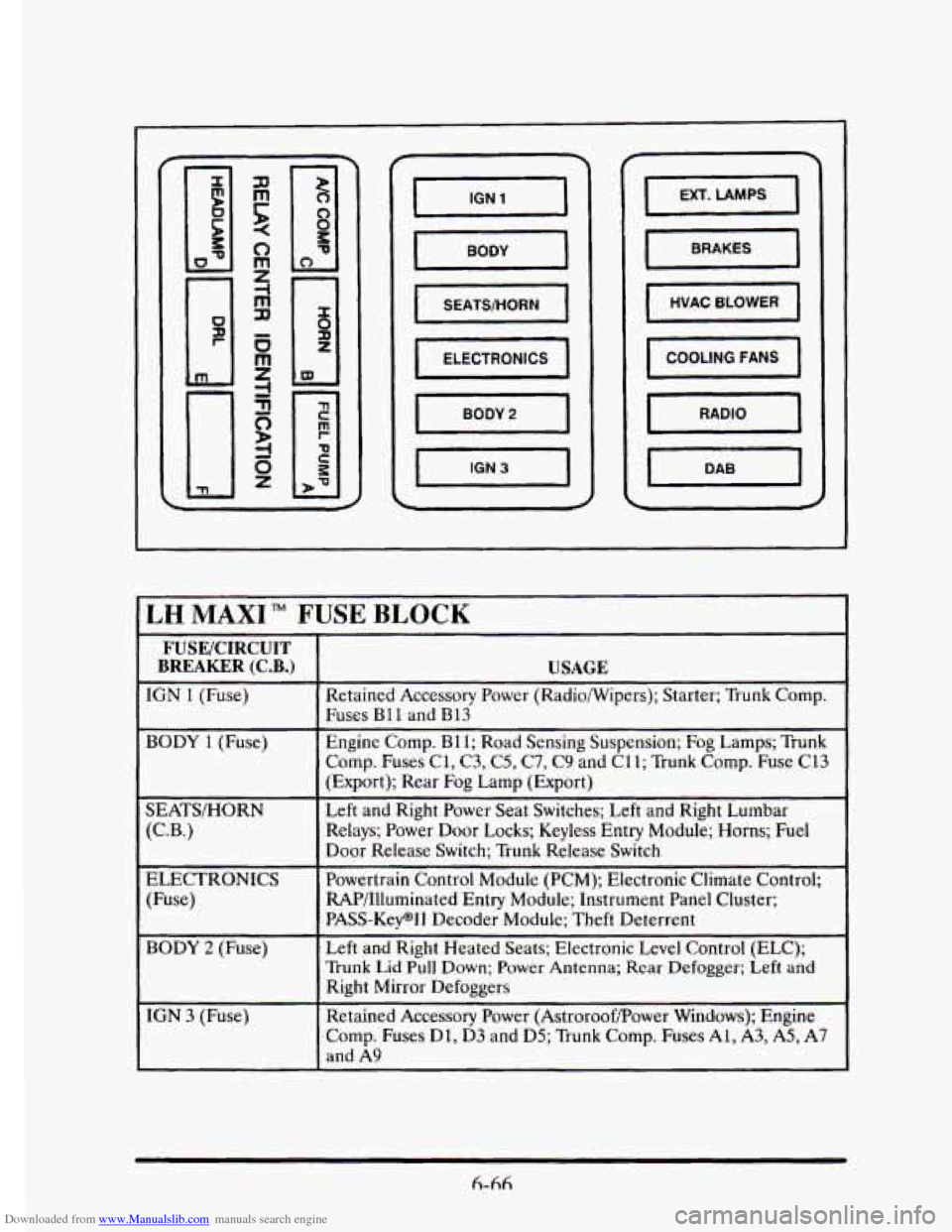
Downloaded from www.Manualslib.com manuals search engine - -r- -
LH MAXI FUSE BLOCK
FUSE/CIRCUIT
BREAKER (C.B.)
IGN 1 (Fuse)
BODY 1 (Fuse)
SEATSIHORN (C.B.)
ELECTRONICS
(Fuse)
BODY 2 (Fuse)
IGN 3 (Fuse)
USAGE
Retained Accessory Power (Radiowipers); Starter; Trunk Comp.
Fuses
B11 and B13
Engine Comp. B11; Road Sensing Suspension; Fog Lamps; Trunk
Comp. Fuses C1, C3, C5, C7, C9 and C11; Trunk Comp. Fuse C13
(Export); Rear Fog Lamp (Export)
Left and Right Power Seat Switches; Left and Right Lumbar
Relays; Power Door Locks; Keyless Entry Module; Horns; Fuel
Door Release Switch; Trunk Release Switch
Powertrain Control Module
(PCM); Electronic Climate Control;
RAP/llluminated Entry Module; Instrument Panel Cluster;
PASS-KeyW Decoder Module;
Theft Deterrent
Left and Right Heated Seats; Electronic Level Control (ELC);
Trunk Lid Pull Down; Power Antenna; Rear Defogger; Left and
Right Mirror Defoggers
Retained Accessory Power (AstroroofPower Windows); Engine
Comp. Fuses
Dl, D3 and D5; Trunk Comp. Fuses Ai, A3, A5, A7
and A9
6-66
Page 331 of 395
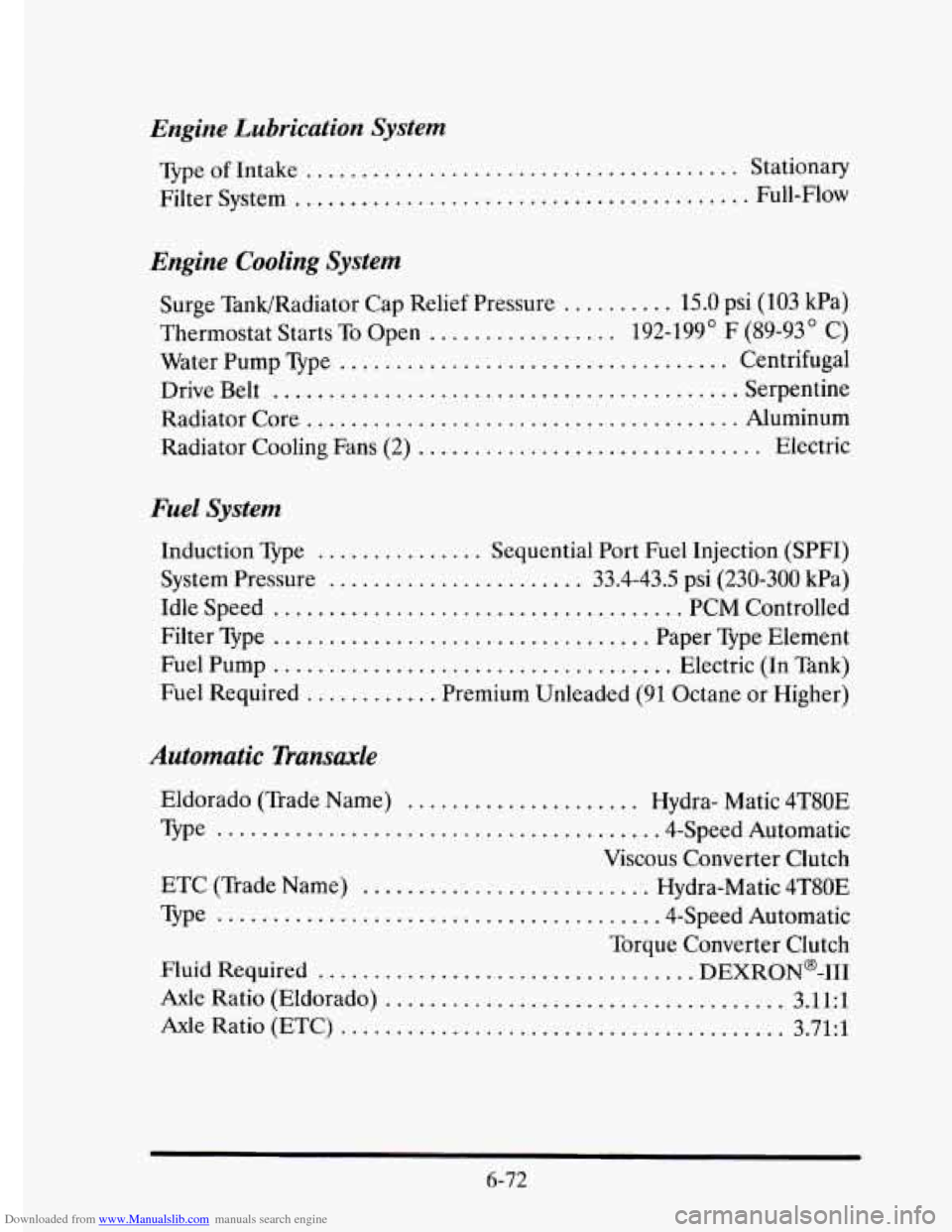
Downloaded from www.Manualslib.com manuals search engine Engine Lubrication System
Type of Intake ....................................... Stationary
Filter System
......................................... Full-Flow
Engine Cooling System
Surge Tank/Radiator Cap Relief Pressure .......... 15.0 psi (103 kPa)
Thermostat Starts To Open
................. 192-199' F (89-93' C)
Water Pump Type
................................... Centrifugal
Drive Belt
.......................................... Serpentine
Radiator Core
....................................... Aluminum
Radiator Cooling Fans (2) ............................... Electric
Fuel System
Induction Type ............... Sequential Port Fuel Injection (SPFI)
System Pressure
....................... 33.4-43.5 psi (230-300 kPa)
Idle Speed
..................................... PCM Controlled
Filter Type
.................................. Paper Type Element
Fuel Pump .................................... Electric (In Tank)
Fuel Required
............ Premium Unleaded (91 Octane or Higher)
Automatic Transaxle
Eldorado (Trade Name) ..................... Hydra- Matic 4T80E
Type ....................................... .4-Speed Automatic
Viscous Converter Clutch
ETC (Trade Name)
.......................... Hydra-Matic 4T8OE
Type
....................................... .4-Speed Automatic
Torque Converter Clutch
Fluid Required .................................. DEXRON@-I11
Axle Ratio (Eldorado) .................................... 3.11:1
Axle Ratio (ETC) ........................................ 3.71:l
6-72